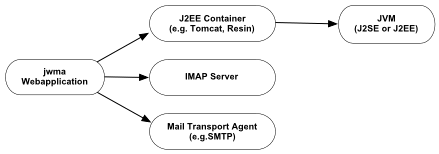| jwma Overview | |
| Main | Deployment | Configuration | Architecture | Development | Screenshots | SF Project Site | |
General
Notes
This document aims at giving the reader an overview (read:
more understanding) about what jwma actually is and what it can do.
What jwma actually is
With the delivered basic view, which is based on standard HTML 4.0 and does
not require any Java functionality on the client side, jwma is primarily a webmail
package, enabling the user to access, manage and compose email using a standard
web browser.
However, due to it's flexible architecture,
that allows to replace elements with other implementations (like for example
a WAP view), jwma can be seen as multi-session server side email client software
based on Java technologies.
Furthermore jwma is open source, and it can be used commercially, as well as
modified for commercial use, without it's license requiring to disclose such
modifications (see license for more details).
If you are interested in the reason for this decision, please see the FAQ.
What jwma is not
jwma's Mail Client Features (showcased by the Basic View)
Dependencies
jwma is a web application that has to be deployed on server side within a J2EE
container (see deployment documentation for more information).
It depends also on an IMAP (v4) server and a Mail Transport Agent (e.g. SMTP
server) as shown in Figure 1.
 |
| Figure 1: jwma Application Dependencies |
The web application itself is build on top of existing functionality implemented
by different open source libraries. Figure 2 gives an overview on these dependencies.
 |
| Figure 2: jwma Library Dependencies |
Information about these libraries can be obtained from well known sites; the following list are links for those libraries which are distributed with jwma (under the terms of their respective licenses as pointed out in the legal notices):
The standard implementations for the Preference Persistence and the Contact Management plugins introduce dependencies on
| © 2000-2003 jwma team |